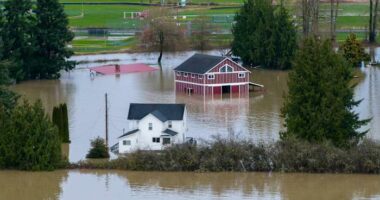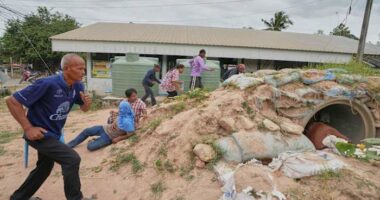Share this @internewscast.com

In the bustling city of Belem, a vibrant and colorful gathering unfolded as Indigenous communities took center stage during the United Nations climate talks. These annual discussions, known as COP30, were anticipated to offer an unprecedented platform for Indigenous voices, and the streets and waterways of Belem teemed with their presence as they sought to make their perspectives known.
The conference, which wrapped up on Saturday in Brazil, left many Indigenous participants reflecting on its impact. Did the event succeed in amplifying their voices? Held in the Amazon, the summit was championed by Brazilian leaders as a chance to empower those who call the rainforest home, aiming to protect this vital ecosystem that plays a critical role in combating climate change by absorbing harmful carbon emissions.
While some Indigenous attendees found strength in the unity shared with tribes from across the globe and celebrated minor victories achieved through the negotiations, there was a palpable sense of missed opportunity. Many felt the event lacked sufficient representation, bold ambition, and tangible actions to address the climate challenges faced by Indigenous communities.
Thalia Yarina Cachimuel, a member of the Kichwa-Otavalo tribe and part of the Wisdom Keepers Delegation representing Indigenous groups worldwide, poignantly expressed a common sentiment: “This was a COP where we were visible but not empowered.”
Despite achieving some progress in language and recognition, the talks did not advance any significant commitments regarding fossil fuel usage, leaving many with mixed feelings about the outcomes.
Some language wins but nothing on fossil fuels
The first paragraph of the main political text acknowledges “the rights of Indigenous Peoples, as well as their land rights and traditional knowledge.”
Taily Terena, an Indigenous woman from the Terena nation in Brazil, said she was happy because the text for the first time mentioned those rights explicitly.
But Mindahi Bastida, an Otomí-Toltec member of A Wisdom Keepers Delegation, said countries should have pushed harder for agreements on how to phase out fuels like oil, gas and coal “and not to see nature as merchandise, but to see it as sacred.”
Several nations pushed for a road map to curtail use of fossil fuels, which when burned release greenhouse gases that warm the planet. Saturday’s final decision left out any mention of fossil fuels, leaving many countries disappointed.
Brazil also launched a financial mechanism that countries could donate to, which was supposed to help incentivize nations with lots of forest to keep those ecosystems intact.
Although the initiative received monetary pledges from a few countries, the project and the idea of creating a market for carbon are false solutions that “don’t stop pollution, they just move it around,” said Jacob Johns, a Wisdom Keeper of the Akimel O’Otham and Hopi nations.
“They hand corporations a license to keep drilling, keep burning, keep destroying, so long as they can point to an offset written on paper. It’s the same colonial logic dressed up as climate policy,” Johns said.
Concerns over tokenism
From the beginning of the conference, some Indigenous attendees were concerned visibility isn’t the same as true power. At the end, that sentiment lingered.
“What we have seen at this COP is a focus on symbolic presence rather than enabling the full and effective participation of Indigenous Peoples,” Sara Olsvig, chair of the Inuit Circumpolar Council, wrote in a message after the conference concluded.
Edson Krenak, Brazil manager for Indigenous rights group Cultural Survival and member of the Krenak people, didn’t think negotiators did enough to visit forests or understand the communities living there. He also didn’t believe the 900 Indigenous people given access to the main venue was enough.
Sônia Guajajara, Brazil’s minister of Indigenous peoples, who is Indigenous herself, framed the convention differently.
“It is undeniable that this is the largest and best COP in terms of Indigenous participation and protagonism,” she said.
Protests showed power of Indigenous solidarity
While the decisions by delegates left some Indigenous attendees feeling dismissed, many said they felt empowered by participating in demonstrations outside the venue.
When the summit began on Nov. 10, Paulo André Paz de Lima, an Amazonian Indigenous leader, thought his tribe and others didn’t have access to COP30. During the first week, he and a group of demonstrators broke through the barrier to get inside the venue. Authorities quickly intervened and stopped their advancement.
De Lima said that act helped Indigenous people amplify their voices.
“After breaking the barrier, we were able to enter COP, get into the Blue Zone and express our needs,” he said, referring to the official negotiation area. “We got closer (to the negotiations), got more visibility.”
The meaning of protest at this COP wasn’t just to get the attention of non-Indigenous people, it also was intended as a way for Indigenous people to commune with each other.
On the final night before an agreement was reached, a small group with banners walked inside the venue, protesting instances of violence and environmental destruction from the recent killing of a Guarani youth on his own territory to the proposed Prince Rupert Gas Transmission Project in Canada.
“We have to come together to show up, you know? Because they need to hear us,” Leandro Karaí of the Guarani people of South America said of the solidarity among Indigenous groups. “When we’re together with others, we’re stronger.“
They sang to the steady beat of a drum, locked arms in a line and marched down the long hall of the COP venue to the exit, breaking the silence in the corridors as negotiators remained deadlocked inside.
Then they emerged, voices raised, under a yellow sky.
___
The Associated Press’ climate and environmental coverage receives financial support from multiple private foundations. The AP is solely responsible for all content. Find the AP’s standards for working with philanthropies, a list of supporters and funded coverage areas at AP.org.
Copyright 2025 The Associated Press. All rights reserved. This material may not be published, broadcast, rewritten or redistributed without permission.











